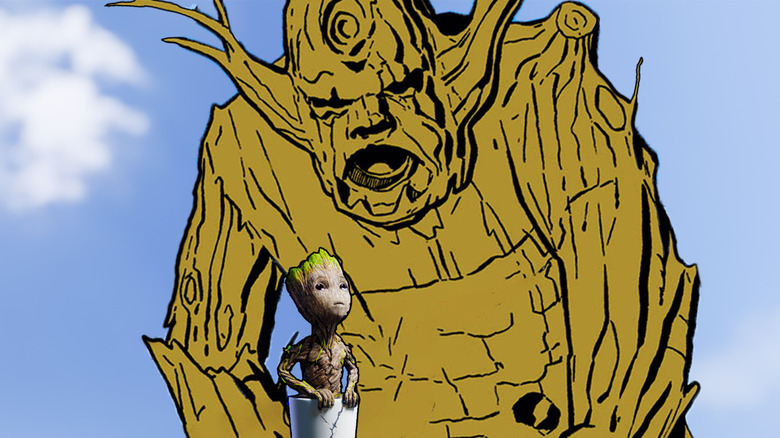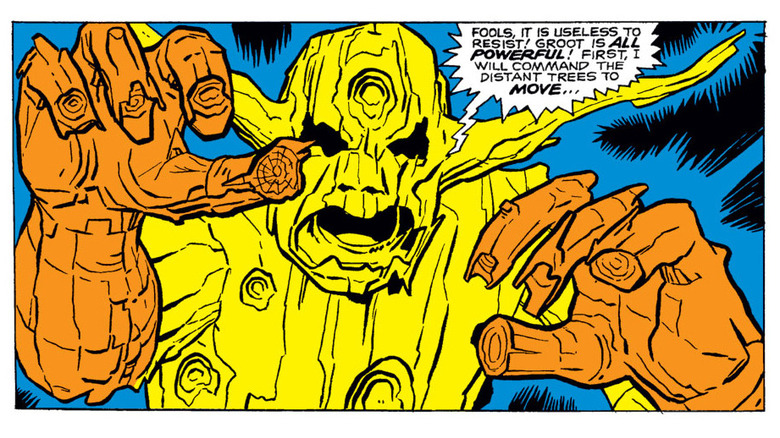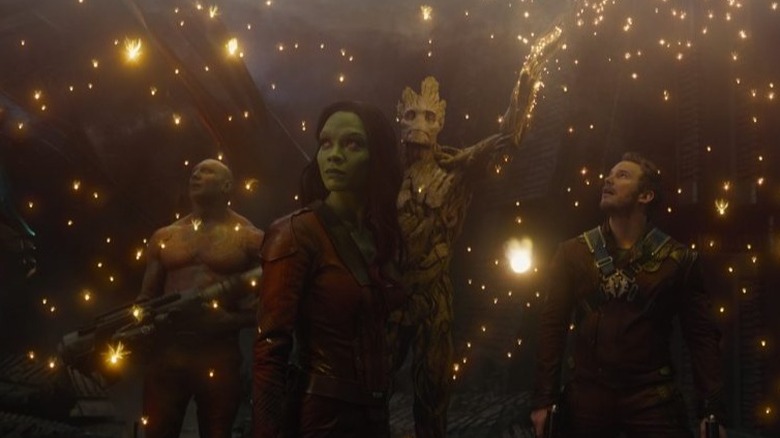Guardians Of The Galaxy's Groot Is Worlds Away From His Marvel Comic Book Origins
Groot appears in different forms in every "Guardians of the Galaxy" movie, but whether he's baby-sized or 10 feet tall, Marvel fans probably know his key characteristics: he's an anthropomorphic humanoid tree, best friends with Rocket Raccoon, and can only say "I am Groot." However, the original Groot was quite a different beast (and had a much larger vocabulary).
Groot's comic debut was "Tales to Astonish" #13, published in 1960. This means he predates every modern Marvel hero barring Captain America and Namor the Sub-Mariner — only he wasn't a hero at first. Co-created by Jack Kirby, Stan Lee and his brother Larry Lieber, the original Groot was a malicious alien invader.
"I Challenged Groot, the Monster from Planet X!" was the eight-page chapter 1 of a four-chapter issue. This means Groot got to be on the cover; his cover appearance was brown in the original coloring, but grey in the modern recolor despite the interior art still showing him as brown.
The story's leads are a married couple, Leslie and Alice. The latter thinks her scientist husband is too much of a wimp, but that changes when their town is besieged by Groot. This Groot can speak normally — he introduces himself as "Monarch of Planet X" and reveals he wants to take a village of Earthlings back to his homeworld as specimens. To do so, he turns a forest of trees into his army. Leslie defeats him with the natural predator of wood: termites. The story plays like a 1950s B-movie on speed-run, but without special effects limitations hampering the imagination.
So, how did Groot go from an invader to a Guardian of the Galaxy? The answer reflects the history of Marvel Comics as a whole.
Marvel monster comics
If you look at Marvel comics published during the 1950s and 1960s, you'll notice some similar titles across the series: "Tales of Suspense," "Amazing Fantasy," "Journey Into Mystery," and the aforementioned "Tales to Astonish."
During the 1950s, the crime, horror, romance, and superhero comics that Marvel (previously Timely and Atlas Comics) had published fell out of fashion. Ground zero for this was the book "Seduction of the Innocent" written by psychiatrist Dr. Fredric Wertham. The not-good doctor argued that comics were a corrupting influence on youth (for instance, he targeted Batman & Robin for promoting homosexuality) which kicked off a moral panic and resulted in the formation of the Comics Code Authority. What the Hays Code was for movies, the CCA was for funny books; comics couldn't be scary, sexy, or promote immoral and "un-American" values.
Now under stringent censorship, Marvel's bread-and-butter became sci-fi comics featuring outrageous monsters and aliens. These played to a similar niche as horror comics, but were brighter and pulpier. Of course, Marvel eventually did get back into the superhero business when Kirby and Lee created "The Fantastic Four" in 1961. This shift was reflected in how the old monster comics started to feature superheroes instead; eventually, they were all rebranded to reflect this. The fifteenth and final issue of "Amazing Fantasy" was the debut of Spider-Man; the series was then supplanted by "The Amazing Spider-Man." "Tales to Astonish" became "The Incredible Hulk," "Tales of Suspense" spun off into "Captain America" and "The Invincible Iron Man," and "Journey Into Mystery" became "The Mighty Thor."
However, the science-fiction comics Marvel had been publishing paved the way for the superhero renaissance. Barring Thor, Marvel's heroes all had origins rooted in science fiction. Stan Lee himself joked about how often he used radioactivity to give his superheroes their powers because the effects seemed scientific.
Reborn as a Guardian of the Galaxy
Marvel's superhero writers would sometimes revive characters from the publishers' monster comics era. The alien dragon Fin Fang Foom first appeared as the star of "Strange Tales" #89 in 1961. In the 1990s, he was turned into an Iron Man villain; the Mandarian's 10 Rings were revealed to be inventions of Foom's race, the Makluans.
Groot is in a similar boat; after a few decades of obscurity, he finally became prominent and heroic in 2008. The Guardians of the Galaxy as fans of the Marvel Cinematic Universe know them are a recent creation, a product of the crossover event "Annihilation: Conquest." The premise is that Ultron conquers the galaxy and various heroes/villains must unite against this threat. The story's leads/future Guardians were pulled from all corners of Marvel's cosmic history: Gamora and Drax were created by Jim Starlin, Star-Lord and Mantis by Steve Englehart, and Rocket Raccoon by Bill Mantlo and Keith Giffen. This mini-series is where Groot acquired his speech quirk and friendship with Rocket. After "Annihilation: Conquest" ended, writers Dan Abnett and Andy Lanning began a new "Guardians of the Galaxy" comic. This run was the (loose) inspiration for James Gunn's film trilogy.
Groot's star has risen so far that he even received a six-issue solo series in 2015, written by Jeff Loveness and art by Brian Kesinger. This series contained a twist: the Guardians of the Galaxy Groot and "Tales to Astonish" Groot were actually two separate individuals. This sort of retcon, attempting to reconcile differing characterization, is common in superhero comics. It remains to be seen if we'll get a villainous variant of Groot in the MCU though.
"Guardians of the Galaxy Vol. 3" debuts in theaters on May 5, 2023. "Tales to Astonish" #13 can be read on Marvel Unlimited.


